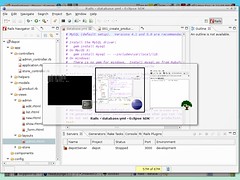Just in case some of you thought all I did on my holiday weekend was fish and tool around in the boat, let me assure you that when it’s in the 50’s and raining, I’m just as capable of entertaining myself with little technical projects. Thus it was yesterday that I finally got the AIGLX/Compiz combination up and running on my laptop in a more than usable form.
AIGLX, for those of you who aren’t familiar with it, is probably best described as a next generation graphics project aimed at keeping up with some of the eye candy in OS X and the forthcoming Vista. Like its more aggressive cousin Xgl, it serves as the foundation for OpenGL compositing managers like Compiz or more cutting edge versions of Metacity which provide the features. In English, that means that AIGLX and Xgl are essentially the basic graphics foundation or framework, and Compiz is the technology that builds on top of that and does all sorts of fancy rendering tricks.
While I have in the past gotten Xgl to build and run, you may recall that it was far too slow to be useful. This is perhaps not surprising, given that the Thinkpad X series laptops which I favor are ultralights and thus are not blessed with the latest in graphics technology. You may also remember that the last time I tried to install AIGLX, it ran without window borders and broke suspend on my laptop – which actually was an improvement of an earlier effort that turned my desktop into a series of blue cubes.
Despite those setbacks, I remain a sucker for eye candy and so persevered, finally succeeding yesterday. I’m delighted to report that the x60s is not only capable of running both AIGLX and Compiz, it does so at a speed easily comparable with the more traditional X/Metacity approach. Having used it only for about 24 hours, I feel comfortable in assessing the packages in simple terms: they. are. awesome. Even things that I thought were semi-pointless like wobbly windows are borderline useful, and quite pleasant from a user experience perspective. The real productivity benefits, however, lie in the ability to quickly and dramatically manipulate the desktop; Alt-Tab now includes thumbnails and application icons for quicker browsing, dragging the mouse up the right hand corner organizes all of your windows on to one screen to make them more easily navigable, and Ctl-Alt-Left or Right turns your desktop into a cube and toggles you back and forth between work sessions. Time will tell how significant these things are in terms of my efficiency, but I’m already seeing benefits.
Beyond the actual functionality, these projects have a higher level importance. While I’ve argued for some time that Linux has been on par with Windows in terms of the quality of the GUI – Windows XP being no great shakes in that department as far as I’m concerned – Apple’s dynamic and visually appealing OS X was clearly the leader of both by a significant margin. Neither AIGLX/Xgl with Compiz/Metacity will change that by themselves – they’re enabling technologies, remember, not beautiful in and of themselves – but for the first time Linux is getting close to having the technology necessary to match OS X. What’s needed now, in my view, are Tango-like efforts to provide polished (sorry, Mark), pretty icons, menus, themes and such that heavily leverage the capabilities the new technologies provide (transparency, flexible windows, desktop organization, and so on). It’s not that the themes currently available in the cgwd-themes package are not impressive – they are – but rather that they’re usually incomplete, and have minor little flaws or bugs (just because you have transparency doesn’t mean you should use it everywhere ;). While folks like me will put up with those, normal users will not.
As any of the designers from Apple or Microsoft could probably tell you, delivering beautiful yet functional designs is typically easier said than done. But I’ve got a lot of faith in the ability of the GUI community to solve this problem. One critical problem with Compiz, for example, the inability to suspend – already has a workaround.
Anyhow, if you’re on Linux and want to give AIGLX/Compiz a shot – keeping in mind my dire warnings that it may very well break your desktop – this is what worked for me. I’ve also written it up for Thinkwiki. One caveat; a couple of the folks from the Ubuntu community who followed my path have apparently had some problems, so tread carefully.
Otherwise, enjoy the sweet, sweet taste of eye candy 😉
Disclaimer: The x60s I’m running off of was donated by Lenovo for the purposes of testing.

